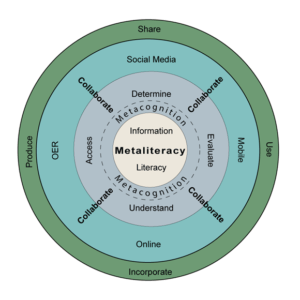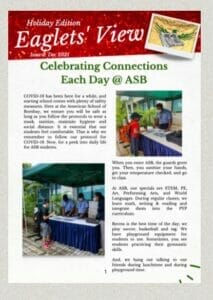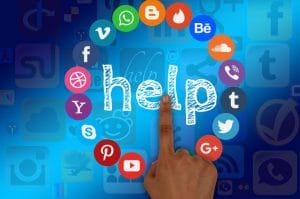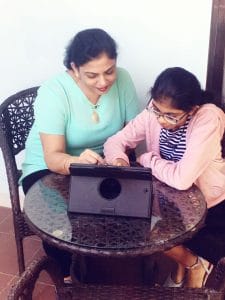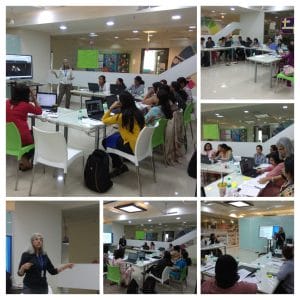Librarians, books, reading, new technology tools, digital literacy, and communication are components in the repertoire of a dynamic evolving role of Librarians. And, we all know that literacy is not only reading, writing, information gathering & evaluating but becoming and supporting students into becoming Metaliterate.
What is Metaliteracy?
Metaliteracy has multiple layers. The first layer for Metaliteracy librarians is to start from Transliteracy. According to Metaliteracy: Reinventing Information Literacy to Empower Learners By Thomas P. Mackey, Trudi E. Jacobson says, Transliteracy emerged outside of the Librarians role where teaching and helping students create knowledge by deciphering from text to physical atlases to Google maps, interactive eBooks, video tutorials, and various Tedx and other social channels based on interests and learning experiences. We consume multimodal literacy, including media literacy, visual literacy, information literacy, & multicultural literacy.
In my opinion, Transliteracy falls directly in the purview of the librarians. It is rethinking our role when creating library plans/curricula. And it might seem practical to include Transliteracy rather than merely – information or media or other literacies since it falls into the heart of the librarians’ domain.
Understanding Transliteracy
Understanding transliteracy helps librarians open up their library curriculum framework and not bottle them into information, technology, or the Literacy Strand. According to T. Ipri, Transliteracy allows librarians and teachers to be fluid and apply a unified approach to literacy rather than focusing on technology tools.
Communications a critical aspect of Transliteracy
Adopting Transliteracy as the basis for learning allows librarians to design instructions where students become the owners, authors, or media creators of their original work. They interact with all forms of modalities: print to all forms of social network platforms to receive information.
Independent Projects
Several years, ago keeping this in mind, the Technology Coach and I embarked on this Independent Project with Elementary School students, giving them the space and time to navigate all forms of sources to arrive at their product/learning. Through these classes, mini-lessons on info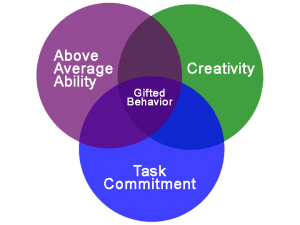 rmation searches, identifying credible resources, navigating different kinds of media: videos, images, infographics, and giving students the space and opportunity to create or learn a new skill. After several months, some students made websites, videos, comic books, eBooks, print books, infographics, and even Google tours and pamphlets based on their interests that varied from space, tourism, dolls, games, technology tools, coding, and more. In my opinion, the students learned at their own pace, driven by their interests. According to Dr. Renzulli’s Total Talent Development Program, when a child above average intelligence is allowed to use their creativity with a dedicated task accomplishment goal, this direction leads to Giftedness.
rmation searches, identifying credible resources, navigating different kinds of media: videos, images, infographics, and giving students the space and opportunity to create or learn a new skill. After several months, some students made websites, videos, comic books, eBooks, print books, infographics, and even Google tours and pamphlets based on their interests that varied from space, tourism, dolls, games, technology tools, coding, and more. In my opinion, the students learned at their own pace, driven by their interests. According to Dr. Renzulli’s Total Talent Development Program, when a child above average intelligence is allowed to use their creativity with a dedicated task accomplishment goal, this direction leads to Giftedness.
Choice Programs
Presently, a similar program called the ‘Choice Program’ is offered in middle school. Students explore their interests in secondary school, and as a librarian, I have had this opportunity to coach and support these mini-projects at school. This is an opportunity where the librarian becomes a part of the teaching faculty to help Metaliteracy.
After School Programs
I often use the after-school program opportunity to learn and hone new skills while giving opportunities to students to practice skills that lead to metaliteracy. Opportunities in photography, designing, and publication areas are paths where students have their voice and choice. Example the eNewspaper Club for Elementary, Middle, and High schools. Students are editors, and designers are part of every activity, and the librarian is the coach/facilitator to support the project.
Liferarian Conference 2021 Learning
I recently attended the Liferarian Conference 2021; the keynote speaker spoke about the importance of deciphering data and analyzing data by asking the 5W at all levels of data scrutiny. Tableau provides resources for teachers and students to learn about data. Understanding variables & field types in data, exploring aggregations, distributions, and learning how to examine the relationships within the data closely. This, I believe, will help us ‘up our game.’
Indeed, the Librarians’ role is evolving and moving in different directions, encompassing both the physical and the digital spheres. Therefore, as I share this post, I use this opportunity to continue learning and share my learning while honing my writing skills.
